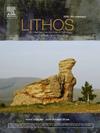Geochronology and geochemistry of Cenozoic magmatism in the north-western Ecuadorian Andes: the role of crustal thickness
IF 2.5
2区 地球科学
Q2 GEOCHEMISTRY & GEOPHYSICS
引用次数: 0
Abstract
The Ecuadorian Cenozoic arc developed over autochthonous continental and accreted oceanic terrains. We reconstruct the tectono-magmatic evolution of the northernmost part of this arc using a comprehensive, multi-proxy approach that incorporates whole-rock chemistry and zircon petrochronology, including U-Pb geochronology, trace element geochemistry, and Hf-O isotopic analysis. Our results reveal two distinct magmatic periods at 41–16 Ma and 14–7 Ma. The older period is characterized by tonalitic rocks that exhibit trace element ratios, δ18O values (6.4–3 ‰), and εHf values (+17 − +12) in zircons that are indicative of highly juvenile sources, while the younger period comprises granodioritic rocks derived from a more enriched reservoir (δ18O: 8.2–5.8 ‰ and εHf: +13 − +7). The older magmas formed within the amphibole stability field in a moderately thick crust (∼ 35 km), while the younger magmas were generated within the garnet stability field in thickened crust (∼60 km). The transition from intermediate crustal thickness and juvenile settings to a thicker crust and more enriched settings occurred at around 14 Ma. This shift was most likely related to the arrival of the young (and buoyant) Nazca plate at the South American margin, which would have resulted in the shallowing of the subduction angle, increased compressional stresses, and facilitated melting of an evolved oceanic crust. This study highlights the utility of zircon petrochronology in unraveling the crustal-scale evolution of Cordilleran arcs, providing valuable insights into the dynamic processes that control continental growth and orogeny.
厄瓜多尔安第斯山脉西北部新生代岩浆活动的年代学和地球化学:地壳厚度的作用
厄瓜多尔新生代弧发育于本土大陆和增生的海洋地形之上。利用全岩化学和锆石年代学(包括U-Pb年代学、微量元素地球化学和Hf-O同位素分析)相结合的综合、多代理方法重建了该弧最北端的构造-岩浆演化。研究结果揭示了41 ~ 16 Ma和14 ~ 7 Ma两个不同的岩浆期。较老时期以锆石中微量元素比值、δ18O值(6.4-3‰)和εHf值(+17 ~ +12)为特征的调性岩为特征,锆石中微量元素比值、δ18O值(8.2 ~ 5.8‰)和εHf值(+ 13 ~ +7)为特征,表明锆石具有高度幼化的成因;较年轻时期则以花岗闪长岩为特征,其成因较富集(δ18O值:8.2 ~ 5.8‰)。较老的岩浆形成于中厚地壳(~ 35 km)的角闪洞稳定场内,较年轻的岩浆形成于厚地壳(~ 60 km)的石榴石稳定场内。14 Ma左右发生了从中等地壳厚度和幼年环境到较厚地壳和更富集环境的转变。这种转变很可能与南美边缘年轻的(浮力的)纳斯卡板块的到来有关,这可能导致俯冲角变浅,增加了挤压应力,并促进了进化的海洋地壳的融化。这项研究强调了锆石岩石年代学在揭示科迪勒拉弧的地壳尺度演化中的作用,为控制大陆生长和造山运动的动力学过程提供了有价值的见解。
本文章由计算机程序翻译,如有差异,请以英文原文为准。
求助全文
约1分钟内获得全文
求助全文
来源期刊

Lithos
地学-地球化学与地球物理
CiteScore
6.80
自引率
11.40%
发文量
286
审稿时长
3.5 months
期刊介绍:
Lithos publishes original research papers on the petrology, geochemistry and petrogenesis of igneous and metamorphic rocks. Papers on mineralogy/mineral physics related to petrology and petrogenetic problems are also welcomed.
 求助内容:
求助内容: 应助结果提醒方式:
应助结果提醒方式:


